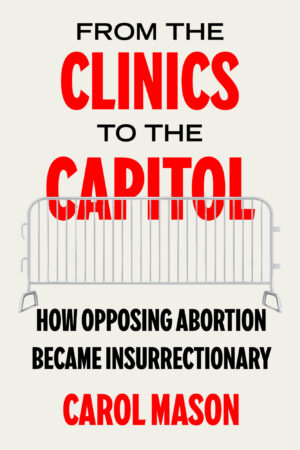Q&A with Carol Mason, author of "From the Clinics to the Capitol"

Carol Mason's From the Clinics to the Capitol explains how white nationalism and authoritarian populism have taken hold in America under the guise of opposing abortion.
Reflecting on her thirty years of analyzing the intersections of race, reproduction, and right-wing movements, she examines primary antiabortion sources that influenced political currents of the last fifty years.
Carol Mason is Professor of Gender and Women’s Studies and Otis A. Singletary Endowed Chair in the Humanities at the University of Kentucky and is the author of several books about the rise of the Right since the 1960s.
In your new book you take the occasion of the January 6, 2021, attack to reflect on how 50 years of protesting abortion has dovetailed with the emergence of a global Right. What will readers learn from your book that will help them understand current events?
Journalists supply hot takes on political violence and policy changes as they happen. I give you the deep dive into the question of how and why anti-abortionists joined other militants in waging war against the federal government. Specifically, you’ll learn how opposing abortion has greased the wheels of intersecting right-wing movements by providing:
- Justifications for spreading false information as a matter of defending Christ and Western civilization;
- Stories repackaging the Cold War–era equation of homosexuality with pedophilia as current moral panics over supposed transgender “groomers” and queer “terrorists;
- Stories that convince women that their sense of national belonging will be obliterated or enshrined depending on their maternal status;
- Laws that effectively deputize the locals, offering rewards for turning in people who seek or help someone seeking an abortion;
- Stories and images that convince white Americans that their offspring are most endangered when in fact African American infant and maternal mortality rates are the highest;
- Nativist depictions of “invading” immigrants who “can’t make white babies";
- Transnational networks that tell white people that the result of demographic changes will be total subjugation and enslavement of them and that, therefore, absolutism is necessary
These issues – and more -- I discuss to help readers understand aspects of right-wing culture that they may experience in everyday life. I hope this book provides people contending with right-wing culture with intellectual and moral support by showing them the historical roots of what may seem to be new, awful developments.
Can you say more about the links between white nationalism and the antiabortion movement? What evidence do you give readers to show those connections?
I look at particular people who worked within antiabortion and a variety of supremacist movements. Many antiabortionists were part of the January 6, 2021, insurrection at the Capitol, thereby contributing to the work of a variety of far right groups, including white supremacists. Often people also point to Eric Rudolph, the convicted clinic bomber, as someone who not only killed people to protest abortion but also espoused supremacist ideas. For my new book, I read closely Rudolph’s prison writings, including a novel, to see how he discusses race and reproduction. I also closely look at Paul deParrie, editor of Life Advocate magazine, who had ties with militia and white supremacist groups. Few people have examined deParrie’s legacy, and I show how he fashioned an absolutist “abortion abolitionist” stance before more recent groups have. So, there are substantial connections among supremacist groups and antiabortion thinking from long ago and from today.

Currently, it’s important to realize that in this historical moment we are contending with a multicultural, multiracial Right. Many antiabortion materials claim to oppose abortion as an extension of racial justice, civil rights, and abolitionism. But by looking closely at those campaigns I found that the use of civil rights and anti-slavery rhetoric is not the same as aiming for an egalitarian society. Often, instead, these groups want a society based on what they call God’s law and a patriarchal “natural order.”
Speaking of religion, news outlets have recently explored the prevalence of the New Apostolic Reformation (NAR) network, which reportedly believes that abortion is an orchestrated industry run by depraved satanists. How important is this religious group and its thinking?
What’s missing for me when I hear these discussions is how much that group mobilizes their people through opposing abortion. As my book makes clear, one doesn’t have to be part of a fringe religious belief system to see images and hear stories derived from antisemitic myths about cannibalistic or satanic politicians and doctors who literally feed off of children, born and unborn. These images and stories have circulated for decades in antiabortion novels, films, billboards, “truth trucks,” protest placards, brochures, haunted houses sponsored by churches, and gory installations that tour campuses. For example, chapter 2 of From the Clinics to the Capitol examines in depth one group that routinely visits colleges and claims that abortion is a “doctrine of demons.” These antiabortion images have primed the American imagination to accept new versions of gory fantasies of dismemberment. Such fantasies are perpetuated by QAnon social media, anti-transgender campaigns, and Groyper memes as well as abortion foes. These proliferating fears and images can mobilize people not merely to protest but also to actually wage war against their own representatives and neighbors.
How do women contribute to the antiabortion movement?
To understand how women were radicalized through opposing abortion, I examine writings by Black right-to-life leader Mildred Jefferson; by the “mother of rescue,” Joan Andrews; by Army of God member Rachelle Shannon; and by more current notables like Abby Johnson, who attended the January 6, 2021, rally on the Ellipse.